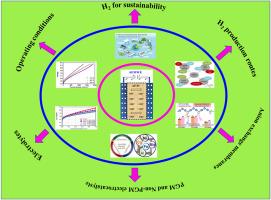Electrochemical hydrogen production through anion exchange membrane water electrolysis (AEMWE): Recent progress and associated challenges in hydrogen production
IF 8.1
2区 工程技术
Q1 CHEMISTRY, PHYSICAL
引用次数: 0
Abstract
Hydrogen (H2) is developing as a promising renewable energy carrier with the potential to reduce greenhouse gas emissions. Anion exchange membrane water electrolysis (AEMWE) provides a promising solution to the current human energy crisis by combining the advantages of both alkaline water electrolysis (AWE) and proton exchange membrane water electrolysis (PEMWE) and can be coupled with renewable energy sources to produce green H2. However, the AEMWE technology remains in the developmental stage and needs further research to compete with AWE, PEMWE, and solid oxide electrolysis cells (SOEC) regarding performance and durability. The current review discusses the recent progress of AWE, PEMWE, SOEC, and AEMWE with their associated challenges and drawbacks. A state-of-the-art critical analysis on anion exchange membranes (AEMs) with their mechanical properties, PGM and non-PGM based electrocatalysts for hydrogen evolution reaction (HER) and oxygen evolution reaction (OER), the performance of different electrolytes with non-PGM electrocatalysts in the AEMWE and the effect of various operating parameters such as temperature, pressure, and electrolyte flow rate on the performance of the AEMWE system are presented in detail. The techno-economic and environmental assessment of AEMWE technology for H2 production indicates that composite mixed matrix AEMs which could work at high temperature and pressure will provide sustainable opportunities in the automobile industry.

通过阴离子交换膜电解水(AEMWE)进行电化学制氢:制氢领域的最新进展和相关挑战
氢气(H2)正在发展成为一种前景广阔的可再生能源载体,具有减少温室气体排放的潜力。阴离子交换膜水电解法(AEMWE)结合了碱性水电解法(AWE)和质子交换膜水电解法(PEMWE)的优点,为解决目前的人类能源危机提供了一种前景广阔的解决方案,并可与可再生能源结合生产绿色 H2。然而,AEMWE 技术仍处于发展阶段,需要进一步研究,才能在性能和耐用性方面与 AWE、PEMWE 和固体氧化物电解槽 (SOEC) 竞争。本综述讨论了 AWE、PEMWE、SOEC 和 AEMWE 的最新进展及其相关挑战和缺点。文中详细分析了阴离子交换膜(AEM)的机械性能、基于 PGM 和非 PGM 的氢进化反应(HER)和氧进化反应(OER)电催化剂、AEMWE 中不同电解质与非 PGM 电催化剂的性能,以及温度、压力和电解质流速等各种操作参数对 AEMWE 系统性能的影响。用于生产 H2 的 AEMWE 技术的技术经济和环境评估表明,可在高温高压下工作的复合混合基质 AEM 将为汽车行业提供可持续发展的机会。
本文章由计算机程序翻译,如有差异,请以英文原文为准。
求助全文
约1分钟内获得全文
求助全文
来源期刊

International Journal of Hydrogen Energy
工程技术-环境科学
CiteScore
13.50
自引率
25.00%
发文量
3502
审稿时长
60 days
期刊介绍:
The objective of the International Journal of Hydrogen Energy is to facilitate the exchange of new ideas, technological advancements, and research findings in the field of Hydrogen Energy among scientists and engineers worldwide. This journal showcases original research, both analytical and experimental, covering various aspects of Hydrogen Energy. These include production, storage, transmission, utilization, enabling technologies, environmental impact, economic considerations, and global perspectives on hydrogen and its carriers such as NH3, CH4, alcohols, etc.
The utilization aspect encompasses various methods such as thermochemical (combustion), photochemical, electrochemical (fuel cells), and nuclear conversion of hydrogen, hydrogen isotopes, and hydrogen carriers into thermal, mechanical, and electrical energies. The applications of these energies can be found in transportation (including aerospace), industrial, commercial, and residential sectors.
 求助内容:
求助内容: 应助结果提醒方式:
应助结果提醒方式:


